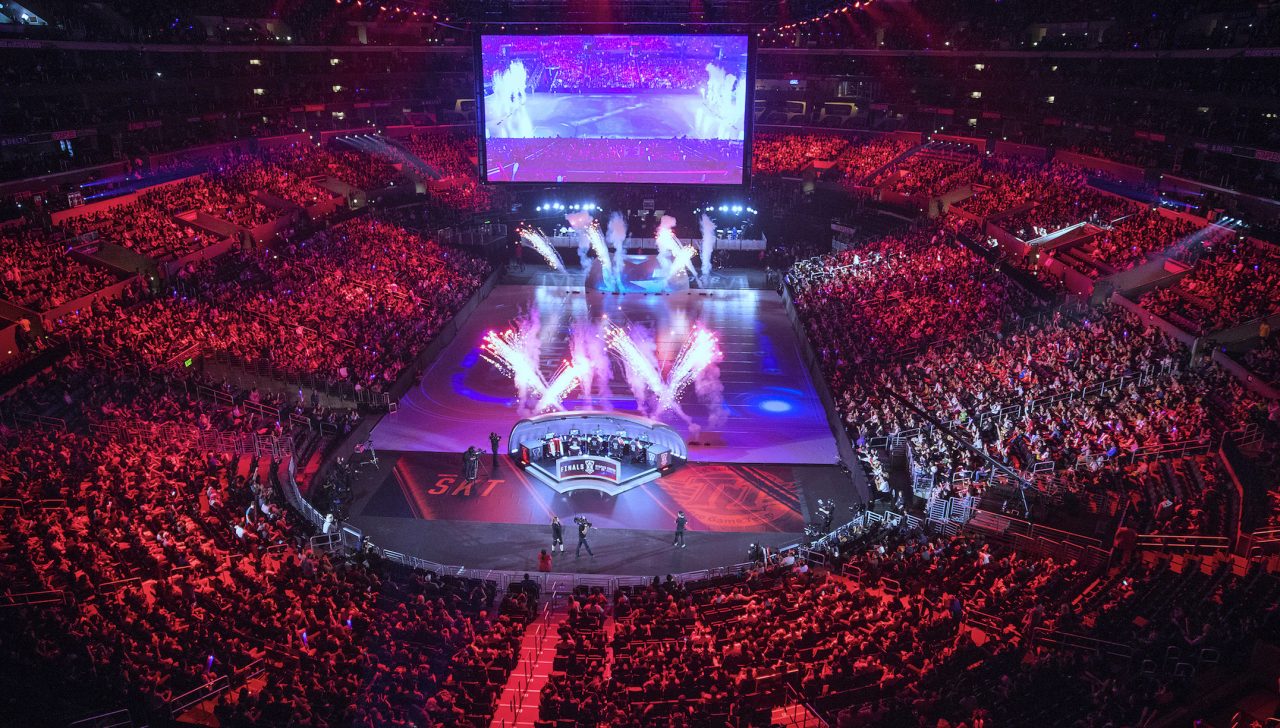This beginner’s guide should serve as a cheat sheet for friends and family wondering what esports is and why it’s worth watching. In this article, you’ll learn the basics of competitive League of Legends, including how the game is played, the road to stardom for professional players, and the different leagues, tournaments, and events that the best players compete in.
Welcome to Summoner’s Rift
League of Legends is a game where two teams of 5 players battle against each other with the goal of destroying the enemy’s most important structure: the Nexus.

Getting to the Nexus isn’t easy. There are only three lanes to the enemy Nexus, and each of them are heavily protected by 3 powerful turrets and wave after wave of angry minions.
As the match begins players enter their respective lanes. The lane they choose to defend is pre-determined by the character (champion) they chose during the champion pick and ban phase that takes place before the action begins.
The top lane features mostly beefy hard-to-kill champions. The middle lane is a mixture of mages and assassins who rely on using magic spells to damage enemy champions.
The bottom lane is the only lane in which both teams send 2 champions to defend: a Marksman (or ADC) and a Support. A Marksman is a glass cannon type who deals large amounts of damage but is extremely fragile.
A Support assists the Marksman with defensive abilities like shields and heals, as well as offensive abilities that freeze and slow enemy champions making them easier to kill.
Here is a montage by professional Support player Bunny FuFuu, mostly playing the champion Thresh.
The only player who does not have a lane assigned to them is the Jungler. The Jungler roams around the map to hunt neutral monsters available to both teams in order to earn gold and experience.
Junglers also attempt to create favorable battles by sneaking up behind enemy champions while their are in an even one-versus-one or two-versus-two battle, giving their team a lopsided advantage. This is called ganking.
In this clip CST NintendudeX successfully ganks TSM top laner Dyrus, turning a 1v1 into a 2v1, which results in a kill for his team.
The beginning of the match is usually calm. All of the players in the game focus on earning gold and experience by killing enemy minions that enter their respective lane. Players can spend this gold on items which make them deal more damage or make them harder to kill.
Occasionally there will be an early battle between opposing players, but because most champions are so weak early in the game before they have bought any substantial items, most players make a strategic decision to focus on farming (killing) minions.
Early level skirmishes are rare, but not impossible. Here’s a clip what what happened when TSM entered their opponents Jungle blind. This put them at a disadvantage for much of the early game.
Because players start the game with few items and little experience they are too weak to focus on destroying the enemy nexus immediately. Instead, both teams focus on getting stronger by accumulating gold and experience by means of farming minions, destroying towers, and killing enemy champions when their Jungler ganks for them.
Volume warning! In this clip the player uses his ultimate, called Super Mega Death Rocket, to steal Baron, and kill 3 enemies. This shows how powerful ultimate abilities can be.
Once champions gain enough experience to reach Level 6 they unlock their Ultimate ability. An Ultimate is the most powerful ability a player has access to but they can only use it every once in a while, with few exceptions. Once a player reaches Level 6 they will look for ways they can help their team outside of their assigned lane.
When a team decides they are collectively strong enough to begin making progress towards the enemy Nexus they will group together. This forces the enemy team to also group up, or else they risk getting picked off one-by-one, losing their turrets protecting the path to their Nexus, or giving away important buffs like the Dragon or Baron.
Team fights usually make or break games, especially later in the game when the death timers are long.
Teams will often fight each other over important objectives such as Dragon, Baron, and turrets. Not only do you earn gold for killing an enemy champion, but you also remove them from the game for a set period of time. Having an extra player or two over your enemies can be the edge you need to secure an important objective that turns the tides of the game.
Games often end after a team convincingly wins a fight and proceeds to push down the remaining towers without resistance, leaving the Nexus to be destroyed freely.
The Path of a Professional League of Legends Player
When you first create a League of Legends account you start off at Level 1 and do not have access to any of the 128 unique playable champions except for the 10 champions that have been selected by Riot as “free to play” for that week
It takes about 365 games to reach Level 30, the highest account level you can get. During pre-30 play you get a feel for the game and begin to understand which champions you enjoy playing most. Once reaching Level 30, Ranked play is unlocked.
There are over 27,000,000 people that log in and play League of Legends on a daily basis. Ranked play is what separates the average players from the good players, and the great players from all the rest.
There are 7 different leagues you can be placed into as a ranked player. Here they are from lowest rank to highest rank: Bronze, Silver, Gold, Platinum, Diamond, Masters, Challenger.
You May Like
Almost 90% of the total League of Legends player base occupies a spot in the bottom two leagues; Bronze and Silver. Just 0.02% of players hold a spot in the Challenger rankings.
Let’s think about that one more time. Just 0.02% of the 27,000,000 players hold a spot in the Challenger rankings. If you’re in the top 0.02% of ANYTHING, you’re damn good at it.
You can’t just pick up League of Legends and turn pro over the weekend. Earning a Challenger ranking is the result of hundreds of hours of gameplay against the best players in the world.
It’sbecause of these highly talented players that League of Legends is the most popular online game played professionally across the entire world.
Gaming As a Viable Career
Getting noticed in esports follows the same formula as it would in traditional sports: consistently perform above the level of your competition. Being in the top 0.02% of all players isn’t enough. You must rise to the top among your fellow 0.02% competitors.
In baseball this means throwing thousands of balls and swinging thousands of bats. In League of Legends this means playing thousands of hours.
An Intel advertisement showing the path of an amateur StarCraft II player is similar to the path of an aspiring League of Legends pro.
Becoming a League of Legends professional starts by dominating the ranked ladder. Active teams are always watching the names that appear atop of the Challenger rankings. If you are consistently placed above other existing pros, it’s going to draw some attention.

What you’re looking for is an offer to join a Challenger Series team. The Challenger Series is the proving ground for the next wave of League of Legends talent.
Aspiring teams can earn a spot in the Challenger Series by first holding a top 16 ranking on the Ranked Team ladder before a predetermined deadline. Then, they must earn first place among their group of 4. This earns them a spot in the Challenger Series.
Going back to baseball, the Challenger Series is essentially the minor leagues in League of Legends. The major league is the LCS.
Challenger Series teams don’t always having gaming houses for the players to live together like LCS teams do, likely because the majority of the Challenger Series is played online, not locally, but they do provide players with a salary, in addition to prize money earned if the team is successful.
There are two ways to get to the LCS (major league) from Challenger Series (minor league):
- Win the Challenger Series Playoffs to guarantee a spot in the LCS.
- The Challenger Series teams that finish 2nd and 3rd in the playoffs face off against two LCS teams that finished at the bottom of the standings. The higher finishing LCS team of the two chooses which Challenger Series team they want to face. The winner of each match earns a spot in the LCS.
Being a top Challenger Series team brings you one step closer to playing in the LCS.
Just to emphasize how big making the LCS is, Team Gravity just recently sold its spot in the LCS to former Los Angeles Laker Rick Fox for $1,000,000.

Show Time: The Perks of Being a Celebrity Gamer
Playing in the LCS is the ultimate goal for aspiring League of Legends professionals. Fame, fortune, and the opportunity to jock for position among the very best players in your respective region (continent).
The reality is becoming a professional League of Legends player is becoming increasingly viable. LCS players earn a salary from Riot Games (the creator of League of Legends), a salary from the team they’re signed to, a home to live in with their teammates (for free), a percentage of tournament winnings, plus money they receive from donations, and advertisements shown, while streaming their non-tournament games.
Kids are watching these professional gamers earn paychecks (bigger than the ones their parents are bringing home) for playing the game they love. It’s no wonder that the esports industry is growing so fast.

There are even players who have realized they can make much more money streaming their non-tournament games full-time than they can from any “real world job”. They now make much more than the average American by streaming themselves playing games in their pajamas at home.
It shouldn’t be a surprise how massive online video game streamers have become.
For decades now it has been commonplace to cheer on your favorite sports team compromised of athletes that are in the top percentile of their respective sport. Watching the top performers of any field is an enjoyable thing. When you want to learn how to make the perfect zesty lemon bars, you tune into Martha Stewart. It only makes sense that those who enjoy playing games want to watch the very best perform at the highest level possible.
We are beginning an era in which professional gamers will be idolized the same way as professional athletes. Pro gamers are extremely relatable for your average League of Legends player.
When you watch Serena Williams turn it on during Wimbledon, there is not a single second in which you think; “I might be able to do that…”. The tremendous athleticism and coordination put on display is so obviously reserved by the top 0.01% and out of your reach.
This is the equivalent to scoring a game winning touchdown for a League of Legends player.
When you watch a professional League of Legends player successfully pull off a low percentage play that requires tremendous skill and reflexes, it inspires you. Even though you know this player puts in endless hours of practice, there is some part of you that wants to open up the game and try to pull it off yourself.
Because if you are successful, the crowd goes wild. It’s not a small crowd, either. Any given regular season LCS match will have hundreds of thousands of viewers watching online. A single player can expect up to 50,000 players watching them play non-tournament games. Gamers really are becoming celebrities.
Worlds: The Holy Grail of Competitive League of Legends
Worlds is to League of Legends is what the Olympics are to traditional sports. This event takes place at the end of every year and features the best 3 teams from each of the most competitive continents across the world.
Worlds is the most prestigious tournament in all of League of Legends. Thus far, the Western teams haven’t had much luck competing against Eastern teams such as those from Korea and China.
It is widely believed that Eastern teams are on a level above Western teams, across all esports, because of how serious they take professional gaming. Gaming is just another job to them. They play an insane amount of hours everyday with constant focus on improvement.
In North America and Europe, “professional gaming” is still somewhat taboo. It’s not something that is recognized as a legitimate career yet, despite the millions of dollars Western gamers are earning.
Nonetheless, Worlds remains the best tournament of the year to watch League of Legends played at the highest level. Watching the very best in the world compete for their Country makes the games that much more electric.

Here’s the attendance numbers for Worlds over the past 3 years:
- 2013: Staples Center in Los Angeles, 11,000 seats (sold out).
- 2014: Seoul World Cup Stadium in Korea, 40,000 seats (sold out).
- 2015: O2 Arena in Berlin, 17,000 seats (attendance not yet released, presumably sold out).
Despite the disappointing venue selection for the finals last year, it’s clear professional gaming is quickly growing into a massively popular spectator sport.
Esports Has a Bright Future
Most mainstream media coverage of competitive League of Legends and other popular titles tends to emphasize just how big esports could get, or how much potential the esports industry has to become the next big thing.
Instead, why don’t we take a moment to stop and smell the roses right now?
There are thousands of jobs being created because of how popular esports is right now. Twitch was acquired for $1,000,000,000 by Amazon. LCS spots are being purchased for $1,000,000. Professional players are being paid BIG salaries, and are still making BIG money from streaming on top of that. Gaming teams have dedicated houses, coaches, analysts, psychologists, and managers.
And yet, as the majority of bloggers say, esports is still on the upswing.
Where will you be when esports goes mainstream? It might be sooner than you think.
















